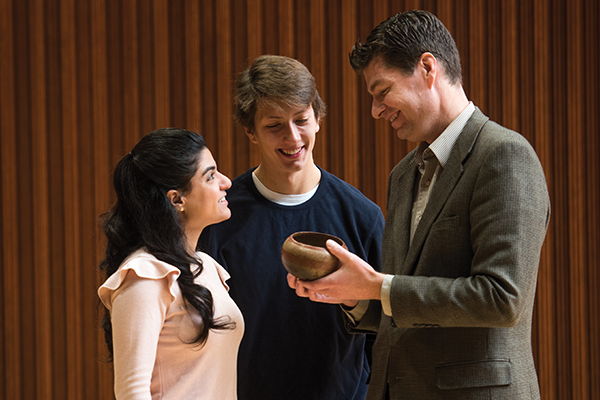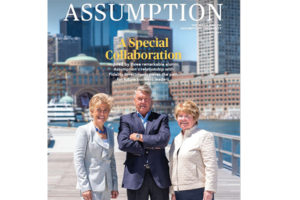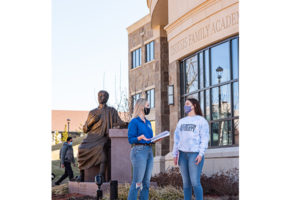
Sometimes the best sleuths aren’t gum-cracking detectives, but history professors on a mission…
The Quest
Last December, Associate Professor of History Mark Christensen, Ph.D., received an intriguing email from Doris Ann Sweet, director of library services at the Emmanuel d’ Alzon Library.
“I have been meaning to ask you about a gift the library received years ago from an Assumption priest,” she wrote. “It is a box about the size of a small moving box (maybe held copy paper), filled with fairly small clay pieces. They are supposedly Pre-Columbian art works, though we have no documentation or direct knowledge of that. Would you be willing to stop by some time to take a look and let us know what you think?”
Prof. Christensen wasn’t anticipating much. “Most tourist sites sell supposedly ‘authentic’ souvenirs that are anything but,” he said. Still, his curiosity was piqued.
The next day, however, as he painstakingly removed paper from more than 30 clay figurines, bowls, and musical instruments, Prof. Christensen was suddenly filled with a treasure hunter’s heady euphoria: these handcrafted artifacts appeared to be “the real deal.”
One of the most tangible clues to the authenticity of the objects lay in the humility of their design. For instance, the flat figurines are the sort called “Gingerbread” figures by archaeologists, because they look so much like the gingerbread men we bake in our own kitchens. In addition, the pottery was ornamented only with clay slip and simple etched designs.
“Fake souvenirs are generally much flashier looking,” explained Prof. Christensen.
The figurines included a ballplayer with a decorative belt and a seated shaman figure with a traditional horned headdress. There was also a copper bell, the sort that might have been worn during religious ceremonies and dances, and an ocarina – a flute-like instrument – shaped like a dog.
If this collection was, indeed, “the real deal,” then Christensen was looking at pre-Columbian artifacts dating back thousands of years.
The Sleuth
A native of Southern California, Prof. Christensen received his first mask and snorkel at age 12, and his love of scuba diving took off from there. As he explored the coast of Mexico for good diving and surfing spots throughout his teen years, Prof. Christensen developed an interest in Latin American culture. A mission trip to Brazil solidified his interest in the region.
His love of international travel, particularly in Latin America, led Christensen to eventually earn a doctorate in history from The Pennsylvania State University. His research interests currently include religion in Colonial Latin America, Nahua and Maya studies, and Nahuatl and Yucatec Maya Colonial texts.
Prof. Christensen is hardly a novice when it comes to uncovering archival gems. In 2012, he was nosing around the Brigham Young University library – “what geeks do on their time off,” he said with a laugh – when he stumbled across a document written in the Mayan language. After painstakingly translating the manuscript and analyzing its contents, he published his work in 2016 as The Teabo Manuscript: Maya Christian Copybooks, Chilam Balams, and Native Text Production in Yucatan.
The book offers fresh insights on how the Mayas negotiated their Pre-Columbian intellectual traditions within a Spanish and Catholic colonial world and “shows what the Mayas truly believed,” he says. Christensen was awarded the prestigious Mexico Section Book Award in the Humanities from the Latin American Studies Association in April 2017 for his efforts.
The Journey to Discovery
Now Christensen faced a new challenge: confirming that the collection of artifacts stored in the institution’s library awaiting discovery was authentic. He started sleuthing the way any clever 21st-century treasure hunter would: by texting photos of the objects to a friend, saying, “You’re not going to believe what I found!”
His friend was none other than renowned archaeologist Ken Hirth, Ph.D., of Penn State, who specializes in studying ancient economies of the pre-industrial world. After examining the initial photographs, Hirth asked for more, then concurred with Prof. Christensen’s assessment.
Unfortunately, the only documentation accompanying the collection was a letter written by the man who had bequeathed it to Assumption upon his death over a decade ago. In that letter, former Assumptionist Michael C.J. Carey specified only that the collection was from Colima, Mexico, and that he had purchased it between 1965 and 1972.
Clearly, additional extensive research was required. Christensen spent the next few months persistently searching for information on the items, their dating, and the culture they represent.
So far, he has determined that this collection contains objects derived from various sources within Colima and Jalisco, Mexico. This area is ecologically diverse, with tropical forests, beaches, and an alpine zone leading to a volcano with a 14,000-foot peak. Human occupation of Colima dates back as far as 1500 B.C.
Despite ethnic and linguistic differences among these native highland populations, all of them shared the practice of burying elite family members in shaft tombs – along with offerings of figurines and ceramics like the ones in Assumption’s library. As recently as the 1960s, archaeology enthusiasts and Mexicans looking for ways to supplement their incomes did a lot of tomb raiding before the government outlawed the practice.
Given that the collection at Assumption is made up of highly stylized examples of red, burnished ceramics of humans and animals, Prof. Christensen has now identified these artifacts as dating back to the Tuxcacuesco-Ortices phase between approximately 300 B.C. and 350 A.D. “The Assumption collection may be modest in size,” he said, “but it is grand in its variety of ceramics and burial offerings from West Mexico.”
His personal favorite artifact? A simple ceramic flute, slightly curved in shape. “This is an object that demonstrated cultural advancement, because it doesn’t really have any practical use,” he said, smiling. “Or maybe I just like it because my mom was a music teacher.”
So what?
When Associate Professor Mark Christensen, Ph.D., teaches history to undergraduates, he has one goal in mind: “I have to arrive at the answer to the question, ‘So what?’ Professors can’t make history all about memorizing dates and reading about dead people, or students will lose interest.”
Christensen is currently working with Visiting Assistant Professor of Art & Design Lynn Simmons to create a display of the Pre-Columbian artifacts in the new Tsotsis Family Academic Center. In answer to that pertinent “So what?” with regard to this rediscovered collection, he hopes the display will lead anyone passing by the glass cases to pause long enough to think about the people who handcrafted these figurines, bowls, and musical instruments more than 2,000 years ago — and reflect on how history connects us all.


